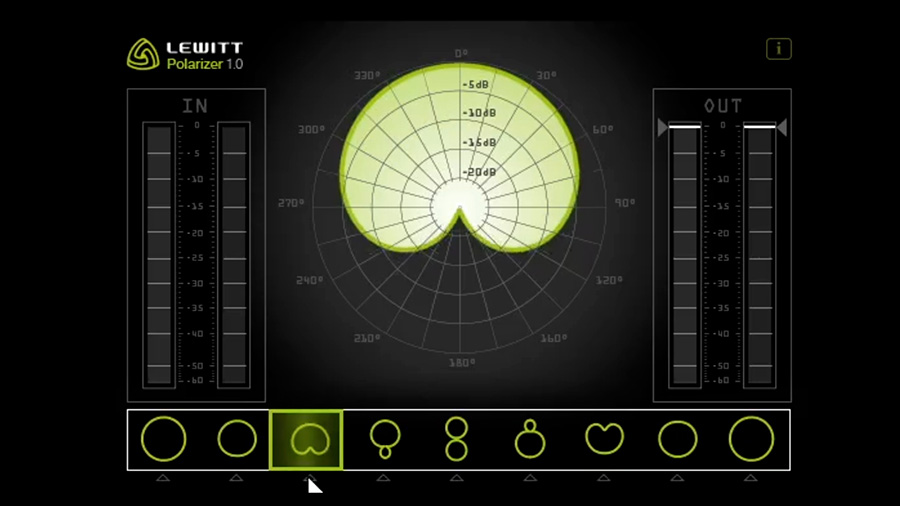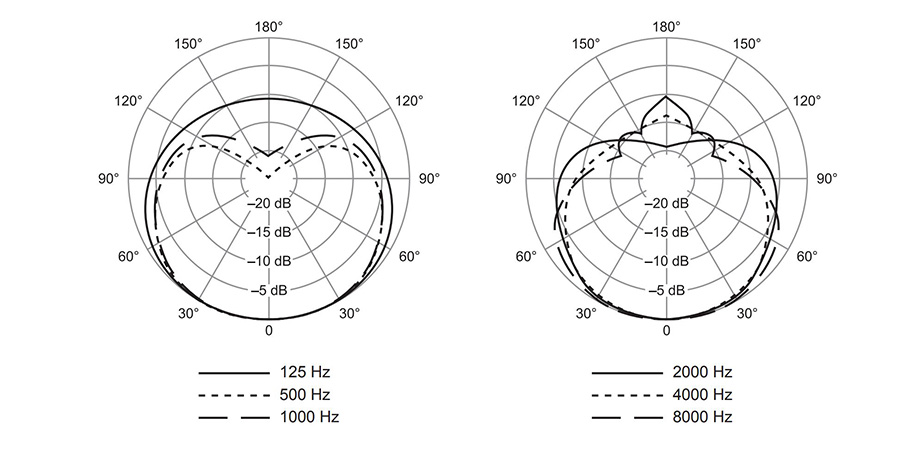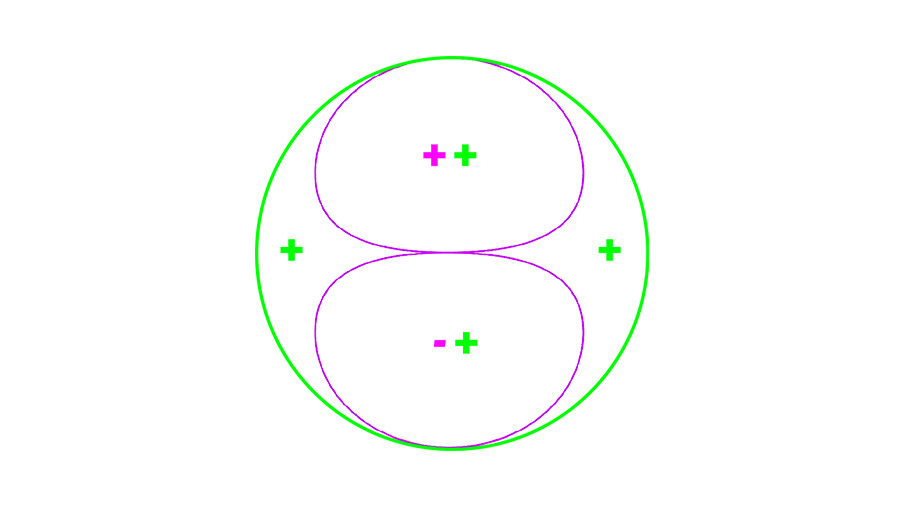What Is A Microphone Polar Pattern?
The polar pattern of a microphone describes its directionality, which is essential information – not only to maximize the signal, but to minimize the noise. It is determined either by the construction of the microphone capsule or the circuitry of a multi-diaphragm microphone.
In this post, we will look at 3 microphone polar patterns – cardioid, figure-eight, and omni. You’ll learn how to read polar pattern graphs and interpret the specs.
In the video above, I’ve set up audio demonstrations so that you can hear each pattern for yourself.
Basic Types of Microphone Polar Patterns
I want to start by looking at the three most basic microphone polar patterns: cardioid, bidirectional, and omnidirectional. Later on, we’ll take a look at how these polar patterns were originally created.
The microphone I use in the video above is called the LEWITT LCT640 TS and it’s the perfect microphone for illustrating polar patterns because it happens to be a uniquely powerful multipattern microphone. Not only can you switch the polar pattern of this microphone before recording, but the polar pattern can also be manipulated after recording!
Check out this screenshot of the plugin that comes with the microphone and allows you to adjust the polar pattern of the mic after recording:

Cardioid (Unidirectional)
The first microphone polar pattern I want to show you is called cardioid. It’s called a cardioid pattern because it resembles the shape of a heart. Cardioid microphones pick up sound best from the front and reject sounds from the rear.

Some cardioid microphones pick up sound best from the end and some from the side. A microphone that picks up sound best from the end is called an axial microphone. A microphone that picks up sound best from the side is called a radial microphone. Generally speaking, the front of a radial microphone is the side with the badge, or label.
Cardioid microphones and other directional microphones are useful when other instruments or noise sources are nearby. If you know that there is a noisy fan in one corner of the room and you can’t turn it off while recording, it might make sense to point the null of a cardioid microphone toward that noise source so that the noise is rejected by the microphone.
Cardioid microphones are really useful in live performances when instruments are in close proximity to each other and you need to capture only the sound of a particular instrument. Cardioids also help to maximize the gain before feedback by rejecting sound coming from the speakers.
If you’re recording in a room with bad acoustics, a cardioid is a popular choice because you can use the directionality of the microphone to maximize the ratio between the direct sound and the reflected sound from walls, floors, and ceilings.
In addition to using a cardioid microphone, you can also do this by bringing the microphone closer to the sound source. Here, you may notice the proximity effect starting to kick in.
The proximity effect is a phenomenon unique to directional microphone polar patterns wherein there is a low-frequency boost as the microphone gets closer to the sound source.
That can be a good thing, if you want to emphasize the lower frequencies in your voice for a radio DJ sound, but it can also have undesirable effects that can result in a muddy mix down the road.
Cardioid is probably the most popular polar pattern, especially for live sound, podcasting, and recording in less-than-perfect acoustic environments.
Figure-8 (Bidirectional)
Another common polar pattern is figure-eight or bidirectional. Microphones with bidirectional polar patterns pick up sound best from the front and the back and reject sound from the sides.

Just like cardioid polar patterns, you can strategically place a bidirectional mic with the nulls pointed toward a noise source to maximize the signal-to-noise ratio.
This is a bit more extreme with a bidirectional mic though, because the on-axis response is narrower than a cardioid pattern. So, while it’s more susceptible to noise from behind than a cardioid would be, it has much better side rejection.
The benefits of using a figure-8 microphone were more difficult for me to see at first, but they are actually quite powerful…
First, they can be used to capture a face-to-face interview or two nearby acoustic instruments, but I haven’t really used them this way because I typically want to keep things on separate tracks so I can control them independently.
Like I mentioned before, bidirectional mics are excellent for capturing sound in one area (like a particular section of an orchestra, for example) while rejecting sound from other areas (like a nearby section in the orchestra). For me, the bidirectional pattern is my go-to for recording acoustic guitar because it helps isolate the track from breathing noise and vocals.
When recording in a nice-sounding room, bidirectional mics allow for a more natural room sound and reverb than you’d get from a cardioid.
There are even some cool stereo microphone techniques that can be used with figure-8 mics, such as Blumlein and Mid-Side.
When it comes to the proximity effect, bidirectional mics are the most susceptible. You can hear that it gets pretty bassy when I’m right up on the mic like this, so I’ll often leave a little space between the source and the microphone when going for a natural sound with a figure-8 mic.
I probably wouldn’t recommend a bidirectional microphone as your only microphone, but they are a very nice addition to your mic locker.
Omni (Omnidirectional)
The last of the basic microphone polar patterns is omnidirectional. Omni microphones pickup sound evenly from all sides.

This can be a good thing if you are recording in a nice-sounding room. It allows you to not only capture the sound of the instrument, but also the reverb and ambiance of the space. If you’re recording in a room without acoustic treatment, you might find the sound of an omnidirectional microphone to be too reverberant and echoey.
There are also a few things that directional microphones suffer from that omnis do not. Omnis are less susceptible to wind noise. They’re less susceptible to plosives, or p-pops. And they’re less susceptible to handling noise.
Omni microphones are also unique in that they don’t exhibit the proximity effect like directional microphones do. As you place a directional microphone closer to a sound source, the low-frequency response will be boosted. The low-frequency response of an omnidirectional microphone is not affected by its proximity to the source – at least not due to the proximity effect of the microphone.
Omni mics are extremely versatile for studio and location recording, but not very common in live sound. If you primarily record on location, you may choose to work with only a pair of omnidirectional mics.
However, if you plan to mostly do multitrack recording, you may want some omnis in your arsenal, but you’ll probably want some directional mics too.
Other Polar Patterns
Beyond these basic polar patterns, there are others such as wide cardioid, supercardioid, and hypercardioid.
These can be useful in situations where you want more directionality or in situations where the noise you’d like to reject is coming from an angle rather than directly from the rear or the sides.
A common example of this are the mics that I’ve just started using for my videos – the Deity S-Mic 2 and S-Mic 2S. These are shotgun microphones with supercardioid polar patterns so that the microphone can be further from me while still maintaining a close sound with minimal noise.

How To Read A Microphone Polar Pattern Graph
When looking through a microphone’s technical specifications, you’ll often see a graph that describes the polar pattern of that microphone. These graphs not only tell us where the microphone is most sensitive and where it is least sensitive, but they also tell us how the microphone responds to various frequencies.

On this graph, the polar pattern response at various frequencies is shown with different styles of lines. This particular microphone, the Shure SM58, is less directional at some frequencies than it is at others.
This highlights one feature associated with directional microphones, called off-axis coloration. A sound will be colored depending on if it is on-axis or off-axis to the microphone. In other words, the frequency response of a directional microphone isn’t necessarily uniform in all directions.
Low frequencies can be removed with a high pass filter, so it’s ok that mics are usually less directional at lower frequencies. But it’s important to look at the off axis response in the frequency range of the source you’re recording. Who knows, you may even use the off-axis coloration to your advantage to slightly darken the sound of the instrument.
How Microphone Polar Patterns Work
Let’s take a closer look at how these polar patterns work – this part is really interesting. In fact, learning how polar patterns work can actually help you to understand a lot more than just polar patterns.
The first microphones were either omnidirectional or bidirectional.
Omnidirectional microphones are sometimes called pressure microphones. For simplicity’s sake, picture a microphone capsule that is sealed on the rear.
Bidirectional microphones are sometimes called pressure-gradient microphones. Again, this is simplified – but imagine a capsule that is open on both sides.
Eventually it was discovered that you could create a cardioid microphone polar pattern by combining a pressure mic and a pressure gradient mic. This diagram might help you to understand how this works…

The pressure microphone (or omni mic) has the same polarity from all directions – we’ll call this positive.
The pressure gradient microphone (or bidirectional mic) has positive polarity in the front and negative polarity in the rear. If sound enters from the side, it will create an equal but opposite change on both sides, resulting in a cancellation.
Where the positive regions of both patterns align, they add together. Where the positive and negative regions align, they cancel each other out. This results in a directional pattern.
Engineers then found that by varying the relative level of the omnidirectional and bidirectional microphones, the combined polar pattern would have an even narrower or wider pickup pattern than cardioid.
This gave us the other polar patterns that I mentioned earlier, such as supercardioid and wide cardioid.
Some modern microphones are capable of multiple polar patterns, such as the LEWITT LCT 640 TS that I’m using here, which can be switched to either cardioid, figure-8, omni, or some options in between.
These microphones generally operate on a different principle. Instead of combining an omni and a figure-8 microphone, they utilize two cardioid polar patterns.
Combining both cardioid signals creates an omnidirectional pattern. Combining both cardioid signals and reversing the polarity of one of them results in a bidirectional pattern. And using only one cardioid, the microphone operates as a simple cardioid microphone.
You can also enhance the directionality of a microphone by utilizing interference tubes, like you’ll find on the shotgun microphones that I mentioned earlier, but I’ll have to save that for another post…
